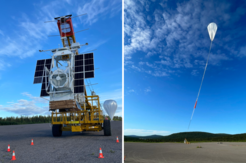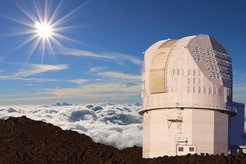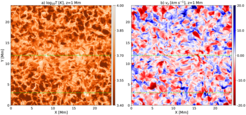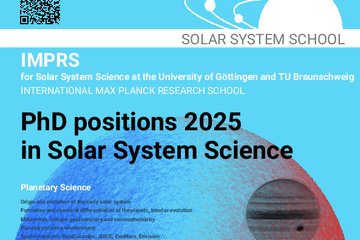
WINSUN - New Windows onto the Sun: Probing the Sun’s magnetic field with an array of new missions and observatories
ERC Advanced Grant
The project WINSUN combines a new generation of observational data with computer simulations to provide a comprehensive view of the Sun's magnetic field. WINSUN is funded by an ERC Advanced Grant (Grant number 101097844) from 2023 until 2028 and led by Sami K. Solanki.
The Sun provides the energy necessary to sustain life on Earth, making it a star of unique importance for human society. It is also the only star whose surface we can resolve to reveal the richness of the complex processes acting there, creating a highly dynamic and varied environment. Much of the structure and dynamics visible on the Sun is caused by the intricately structured magnetic field and its interaction with the turbulent plasma. However, there are considerable gaps in our knowledge of the fundamental physical processes driving the evolution of the solar magnetic field, from its generation to its removal from the solar surface, and how the field drives solar activity and variability, which become manifest in e.g. dark sunspots that repeatedly appear on the Sun’s visible surface, violent bursts of radiation and particles that can reach Earth as solar storm, as well as in longer-term changes in its radiation intensity.
To fill these gaps, the project WINSUN, funded by an ERC Advanced Grant awarded to Sami Solanki of the Max Planck Institute for Solar System Research, will make use of powerful new observational missions and facilities. The time for this endeavor is favorable. While older space probes and telescopes continue to provide researchers with valuable data, most of these facilities are already entering their second decade of operation. With more advanced instruments and state-of-the-art technology, powerful new missions and observatories have just started to provide completely new types of observational data.
- Solar Orbiter (SO), a joint mission of ESA and NASA, has started in the beginning of 2022 exploring the Sun from an elliptical orbit that approaches the Sun regularly to within one-third of the distance between Earth and the Sun, and provides data with the highest spatial resolution ever. Of particular interest for this project are two instruments on SO, the Polarimetric and Helioseismic Imager (PHI), a vector-magnetograph that provides high-resolution maps of the magnetic field in the photosphere, and the Extreme Ultraviolet Imager (EUI) that provides images of the solar corona in ultraviolet light in unprecedented detail. In the coming years, the probe’s increasingly inclined trajectory will for the first time allow full views of the solar poles.

- Sunrise is a balloon-borne solar observatory that after two highly successful week-long flights in 2009 and 2013, suspended from a stratospheric balloon, performed a successful third flight in July 2024 (Sunrise III). With a 1m diameter telescope main mirror (the largest solar telescope to leave the ground), a new, stable gondola and three new, very ambitious spectropolarimetric instruments, Sunrise III represents a big advance on Sunrise I and II. The three instruments allow to simultaneously and co-spatially measure photospheric and chromospheric magnetic fields, flows, etc. in a multitude of spectral lines covering a broad height range. Sunrise III provides co-temporal access to the photosphere and chromosphere, seamlessly covering a wide range of heights thanks to the many observed spectral lines and the three co-observing instruments. This allows following disturbances through most of the photosphere and chromosphere. Along with obtaining seeing-independent, diffraction-limited observations and the capability of observing for 24 hours continuously per day from its circumpolar orbit, this makes Sunrise III unique.

- With a 4 m aperture, the Daniel K. Inouye Solar Telescope (DKIST) on Hawaii is the world’s largest solar telescope by a factor of six in collecting area. DKIST reaches new frontiers in terms of spatial resolution as well as in the light-collecting power required for fast and sensitive polarimetric measurements. One of the key instruments, the Visible Tunable Filtergraph (VTF) is expected to start gathering science data in the near future. The VTF is an imaging spectropolarimeter that will provide maps of the magnetic field at an extremely high spatial resolution in a wavelength range between 520 and 860 nm.

- Aditya-L1 is the first Indian solar space mission. Located in a halo orbit around the Sun-Earth Lagrange L1 point, it collects scientific data since the end of 2023. The Solar Ultraviolet Imaging Telescope (SUIT) on-board Aditya-L1 provides full-disk solar images in the wavelength range 200-400 nm covering the photosphere and chromosphere. These are the first full-disk images of the Sun in this wavelength range, which is critical for the photochemistry of ozone and, thus, of importance for Sun-climate studies.

Solar Orbiter, Sunrise III, DKIST and Aditya-L1 will open new windows onto the Sun and its magnetic field. They will provide the first clear views of the solar poles (Solar Orbiter), and the highest spatial resolution ever in the Extreme Ultraviolet (Solar Orbiter) and in the visible (DKIST). They will also explore a new spectral window onto the solar photosphere and chromosphere (Sunrise III, Aditya-L1). The advanced instrumentation, complemented by novel data analysis techniques and state-of-the-art magneto-hydrodynamic simulations, will allow tackling, often in entirely new ways, long-standing difficult problems in solar physics that have resisted previous attempts at resolving them. Elucidating these will provide deep insights into the life cycle of the magnetic field, and how it affects the Sun’s atmosphere and variability.

A decade’s efforts by Solanki and his group has positioned them at the core of the new instrumentation, data analysis techniques and simulations. Solanki initiated and lead the Sunrise mission, he is Principal Investigator of Solar Obiter's PHI instrument, and he and members of his group are Co-investigators of other Solar Orbiter instruments. Solanki is also Co-investigator of Aditya-L1 and of the VTF instrument at DKIST.
















